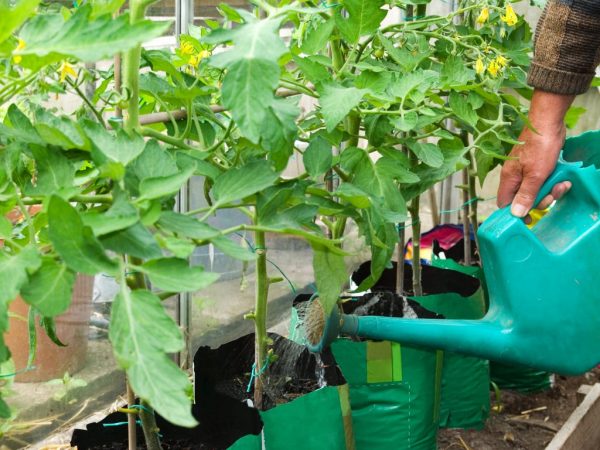Application of potassium monophosphate for tomatoes
When growing vegetables, gardeners often resort to various fertilizers. Potassium Monophosphate for Tomatoes is a well-known mineral supplement that can increase yields.

Application of potassium monophosphate for tomatoes
About the composition and benefits of monophosphate
Potassium monophosphate (otherwise known as potassium dihydrogen phosphate) is a potassium salt of orthophosphoric acid and is available as a white powdery mixture. It can be used as a mineral fertilizer not only for growing vegetables, but also for feeding fruit trees and indoor plants.
Potassium monophosphate for tomatoes stimulates the ripening of vegetable crops, contributes to the preservation of vegetables, for fruit shrubs it acts as a supportive agent that helps to endure cold weather, and for indoor plants it is a prolongator of their flowering.
The composition of potassium monophosphate for groundbait of tomatoes contains:
- phosphorus component oxide - about 50-52%,
- potassium oxide ingredient - about a third of the volume, or about 30%,
- orthophosphoric acid.
Potassium monophosphate is one of the mineral potassium-phosphorus fertilizers for cultivated plants. The amount of potassium contained in it in monophosphate exceeds that of chloride and sulfate and potassium nitrate. The percentage of phosphorus is slightly lower than that of superphosphates.
The use of the preparation for tomatoes increases the resistance of the vegetable crop to diseases.
A highly concentrated agent, potassium monophosphate, due to the presence in the composition of phosphoric acid for feeding tomatoes, quickly dissolves in water. The solubility indices of granular potassium monophosphate powder in an aqueous solution reaches up to 22.5% at a temperature of 20 '. When the temperature rises to a level of 90 ', the solubility of the mixture reaches more than 83%.
Features of fertilization with monophosphate
The introduction of potassium monophosphate for feeding tomatoes during their cultivation occurs according to the instructions when planting tomato seedlings in soil, during planting processing in spring and at the flowering stage.
The use of monophosphate mineral fertilizer can be performed in one of two ways:
- in the form of foliar feeding of tomato bushes,
- by applying to open or protected soil.
As a rule, potassium monophosphate powder for tomatoes is used mainly in dissolved form in the form of self-feeding. However, in some cases it is included as a component of the mineral mixture.
Among the useful properties of potassium monophosphate as a fertilizer for tomatoes, reviews of mineral feeding indicate its compatibility with almost all types of fertilizers, with the exception of those that contain a magnesium and calcium component.In a mixture with nitrogenous compounds, potassium monophosphate has a greater effective effect on the growth and development of the root part of tomato bushes.
Dosage of groundbaits

Be sure to follow the instructions
Depending on the method of feeding tomatoes with mineral fertilizers, instructions for the use of potassium monophosphate are selected.
Top dressing of seedlings
When watering the soil layer with tomato seedlings grown in it, the diluted potassium monophosphate concentrate is diluted with ten liters of water per 10 g of powder or granular mixture. The consumption rate for watering tomato seedlings is approximately 5 liters of an aqueous monophosphate-potassium solution per square meter of area.
Top dressing of bushes on the ground
When feeding tomato bushes planted in open or protected ground, the instructions for using an aqueous solution of potassium monophosphate for fertilizing tomatoes recommends cooking in a proportion of 15 to 20 grams of a mixture per 10 liters. At the same time, the rate of fertilization in the soil is in the range from 3 to 4 liters of the prepared solution per square meter of the area of young plantings and about 5-6 liters for mature plants. This amount is enough for about 4 tomato bushes.
Foliar dressing is carried out in the evening. A two-week interval is made between fertilizing tomatoes. Instructions for the use of potassium monophosphate for foliar feeding of tomatoes does not recommend feeding a vegetable crop more than two times in a row in one gardening season.
Fertilizer reviews and warnings
Reviews of gardeners on the use of potassium monophosphate for fertilizing tomatoes indicate its main advantages when feeding plants:
- increase in fruiting indicators due to the high content of potassium and phosphorus in the composition and their optimal ratio,
- spraying protects the vegetable crop from diseases, fungi and pests, including increasing resistance to powdery mildew,
- accumulation in vegetables of an increased amount of sugar and vitamin components that improve the taste of tomatoes,
- increasing the shelf life of the resulting crop,
- complete digestibility of the mineral supplement by almost all parts of plants due to the high proportion of solubility of the mixture,
- increased frost resistance,
- compatibility of the drug with other dressings, including nitrogen fertilizers,
- no side effects and low impact on changing the acidity of the soil layer during spraying and root feeding.
Gardeners pay attention that it is impossible to soak seeds for future seedlings in potassium monophosphate, since during this period the leading potassium salts adversely affect the development of vegetable crops.
In the conditions of agricultural technology in small and medium-sized areas of growing vegetables with manual fertilization and spraying of tomato bushes, it becomes justified costs, ensuring high yields.
Nevertheless, the reviews of gardeners also contain indications of disadvantages when using potassium monophosphate for fertilizing tomatoes with it:
- solid fertilization does not give such effective results as can be achieved by fertilizing the soil layer and feeding with solutions, since the mixture quickly disintegrates, therefore such a preparation is practically not suitable for pre-winter feeding in open ground,
- the bait of a plant planted in a greenhouse should be accompanied by excellent lighting and regular ventilation, since potassium monophosphate shows the greatest efficiency under moderately humid and cool climatic conditions that do not allow the components to quickly disintegrate,
- along with the active growth of tomatoes, potassium monophosphate also gives rapid growth to weeds.
Hygroscopic potassium monophosphate for tomatoes, when wet, loses its useful qualities, ready-made solutions in air and when exposed to sunlight reduce their stability, therefore the drug is recommended to be used immediately after opening and preparation of solutions.


